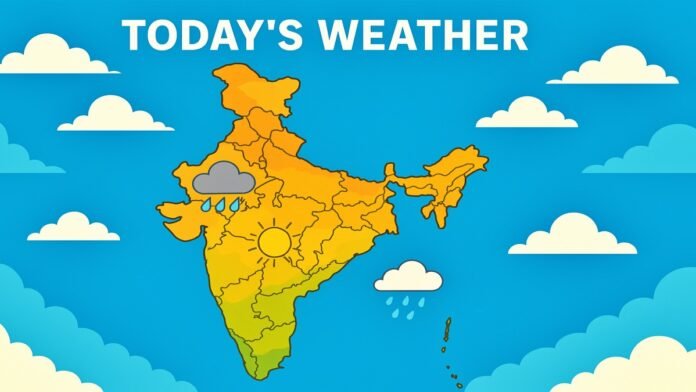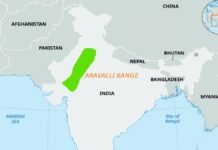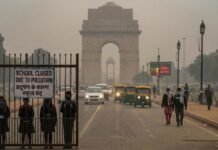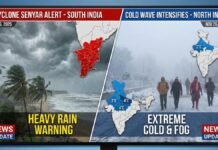
Key Points
- Delhi’s AQI remains in severe category at 418 with multiple monitoring stations exceeding 450
- Cold wave alert issued for western Madhya Pradesh, Chhattisgarh, and Rajasthan until November 15
- Uttar Pradesh towns record temperatures below 10°C with Etawah dropping to 8.4°C
- Heavy rainfall forecast for Tamil Nadu, Kerala, and Puducherry over next two days
- Western disturbance expected to bring rain and snowfall to Jammu and Kashmir on November 16
- Dense fog reducing visibility to 500 meters at Delhi airports affecting flight operations
New Delhi: The national capital region continues to gasp under severe pollution for the second consecutive day, with Delhi’s Air Quality Index (AQI) recorded at 418 on Wednesday, according to Central Pollution Control Board (CPCB) data. The city shares the dubious distinction of being India’s most polluted city alongside Jind in Haryana. Out of 39 monitoring stations across Delhi, most recorded AQI levels exceeding 400, firmly in the severe category that poses serious health risks even to healthy individuals.
Wazirpur, Chandni Chowk, and Bawana emerged as the most polluted locations, with AQI values surpassing 450, falling into the severe-plus category. The situation in neighboring NCR cities mirrors Delhi’s plight, with Noida recording 408 and Rohtak at 406. Stubble burning in neighboring states contributed a staggering 22.5% to Delhi’s PM2.5 levels on Tuesday, the highest this season, exacerbating the already critical air quality situation.
Visibility Crisis Disrupts Air Traffic
Dense smog and fog have dramatically reduced visibility across Delhi-NCR, creating hazardous conditions for aviation and ground transportation. Safdarjung Airport recorded its lowest visibility at just 500 meters at 6:30 AM on November 12, which marginally improved to 800 meters by 7:30 AM. Palam airport experienced similarly poor conditions with 800-meter visibility persisting from 7:00 AM to 8:30 AM before gradually improving to 900 meters.
The toxic haze results from a combination of high humidity, low wind speeds dropping to below 12 kmph, and minimum temperatures hovering between 9°C and 12°C. The CPCB classifies air quality on a scale where 0-50 is ‘good,’ 51-100 ‘satisfactory,’ 101-200 ‘moderate,’ 201-300 ‘poor,’ 301-400 ‘very poor,’ and 401-500 ‘severe,’ making Delhi’s current levels extremely dangerous for all residents.
Cold Wave Tightens Grip on Central India
The India Meteorological Department (IMD) has issued cold wave warnings for western Madhya Pradesh, Chhattisgarh, and Rajasthan, with conditions expected to persist until November 15. Cold wave to severe cold wave conditions are also forecast for parts of East Madhya Pradesh, with temperatures dropping 2 to 5 degrees Celsius below normal across the plains of northwest and adjoining Central India.
The cold wave has spread beyond its initial western Madhya Pradesh epicenter to engulf eastern regions, including Jabalpur, Sagar, Rewa, and Shahdol. Weather experts attribute this early intensification to Western Disturbances that became active in the Himalayan region about a week earlier than usual, triggering snowfall in Jammu & Kashmir, Uttarakhand, and Himachal Pradesh. Cold winds from these snow-covered northern regions are now cascading southward, intensifying the chill across central India.
Uttar Pradesh Shivers Under Sub-10°C Temperatures
Uttar Pradesh is experiencing particularly harsh winter conditions with nighttime temperatures plummeting across multiple cities. Etawah recorded the state’s lowest minimum temperature at 8.4°C, a dramatic 5.1°C below normal for this time of year. Kanpur Nagar registered 10.0°C (3.4°C below normal), while Bareilly stood at 10.4°C (4.3°C below normal). Ayodhya and Bulandshahr both recorded 11°C as minimum temperatures.
Despite the cold nights, daytime conditions remain relatively pleasant with sunny weather. Kanpur IAF recorded the highest maximum temperature at 30.2°C, while Bahraich saw a slight increase reaching 30.2°C. However, winds blowing at speeds of 17 to 20 kilometers per hour during morning and evening hours are expected to drive temperatures further down from November 13 onwards. The IMD forecasts that Delhi-NCR will experience maximum temperatures between 24°C and 28°C, with minimums ranging from 9°C to 12°C until November 15.
Himalayan Snow Amplifies Winter Intensity
The Western Disturbance currently active over the Himalayan region is bringing significant weather changes to mountain states. On November 16, many areas of Jammu and Kashmir are expected to experience cloudy skies, light winds, and rainfall, accompanied by snowfall and dense fog in higher elevations. This marks a continuation of snow activity that began earlier in the season across Gulmarg, Zojila Pass, Sonmarg, and Gurez Valley.
In Himachal Pradesh, the IMD forecasts minimum temperatures in Keylong, Tabo, and Kukumseri to plunge to -4°C. Other popular hill stations, including Shimla, Solan, Mandi, Kangra, Bilaspur, Dharamshala, Manali, and Una, are experiencing temperatures between 2°C and 7°C, creating intense cold conditions for residents and tourists alike. The Rohtang Pass and Dhauladhar ranges have already received fresh snowfall, painting the landscape white.
Uttarakhand’s cold wave has worsened conditions in Dehradun, Haridwar, Pithoragarh, Nainital, and Almora, where the combination of cold winds from snow-covered peaks and dropping temperatures is creating harsh winter weather earlier than usual.
Dense Fog Blankets Northern Plains
The IMD has issued warnings for widespread fog conditions affecting multiple northern states. Dense to very dense fog, which reduces visibility to between 50 and 200 meters, will continue to envelop Delhi, Rajasthan, Haryana, Punjab, Uttar Pradesh, and Bihar during night and early morning hours over the next 2-3 days. Light to moderate fog is also expected in Odisha, Himachal Pradesh, Assam, Haryana, Chandigarh, and Delhi.
The fog phenomenon results from high humidity combined with low wind speeds and falling minimum temperatures. In Delhi-NCR, shallow fog or smog is particularly problematic during morning hours, with visibility gradually improving only after 9:00 AM. Northwestern winds will dominate the region with speeds varying from 5 to 20 kmph during the day but becoming lighter at night, allowing fog to settle more densely.
South India Braces for Heavy Rainfall
While northern and central India battle cold and pollution, southern states face a different weather challenge. A cyclonic circulation over the southwest Bay of Bengal is triggering significant rainfall across Tamil Nadu, Kerala, and Puducherry. The IMD has forecast heavy to very heavy rainfall at isolated places over these regions for the next two days, with thunderstorms accompanied by lightning creating potentially dangerous conditions.
Tamil Nadu is expected to experience isolated heavy showers on November 13, with additional rainfall predicted for November 17 and 18. Kerala and Mahe will receive heavy rainfall on November 12 and 13, while coastal Andhra Pradesh, Yanam, and Rayalaseema are likely to see heavy downpours on November 17 and 18. In the past 24 hours ending at 8:30 AM on November 12, heavy to very heavy rainfall between 7 cm and 20 cm was recorded at isolated locations in Tamil Nadu, while parts of Kerala saw substantial precipitation.
The weather department has issued thunderstorm and rain alerts for Kerala, Tamil Nadu, Andaman and Nicobar Islands, and Lakshadweep on November 13. Thunderstorms accompanied by lightning are forecast to persist over Tamil Nadu, Kerala, Mahe, and parts of Karnataka for the next seven days, requiring residents to remain vigilant.
Temperature Departures Signal Extreme Conditions
Meteorological data reveals significant temperature anomalies across multiple regions. Minimum temperatures are below normal by -1.6°C to -3.0°C at many places over Konkan & Goa and at a few places over Marathwada. Jharkhand is experiencing appreciably below normal temperatures of -5.0°C to -3.1°C at several locations, contributing to the intensifying cold wave conditions.
The northeastern region is expected to experience light to moderate fog over the next five days, with minimum temperatures anticipated to drop by 2-3°C. Temperature departures in central and northwestern India remain 2 to 5 degrees Celsius below normal, creating the classic cold wave pattern that typically develops in late November but has arrived earlier this year due to premature Western Disturbance activity.
Multi-State Weather Advisory in Effect
The combined impact of severe pollution, cold waves, dense fog, and heavy rainfall has prompted the IMD to issue comprehensive advisories across multiple states. Citizens in cold wave-affected areas are advised to stay warm, wear layered clothing, and take necessary precautions, especially vulnerable populations, including children, elderly persons, and those with respiratory or cardiac conditions.
In Delhi-NCR, the air quality early warning system predicts very poor air quality from Thursday through Saturday, though marginally better than the current severe levels. Residents are urged to minimize outdoor exposure, use N95 masks when venturing outside, and keep indoor spaces well-ventilated while avoiding peak pollution hours. Schools and outdoor activities may face restrictions if AQI levels remain in the severe category.




















































